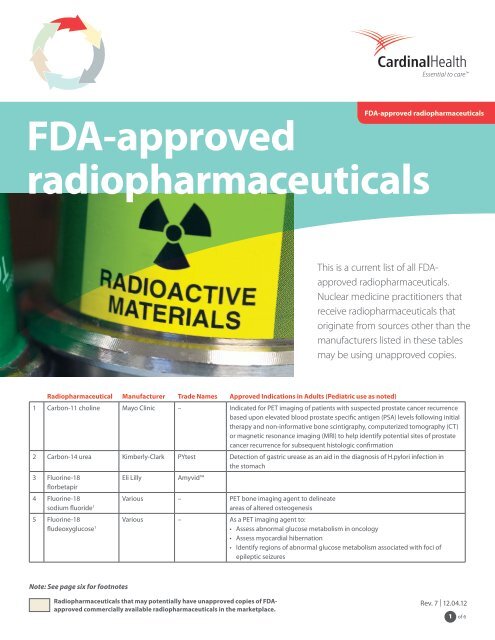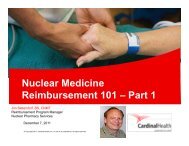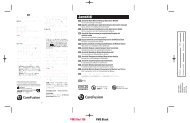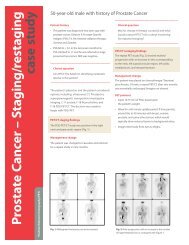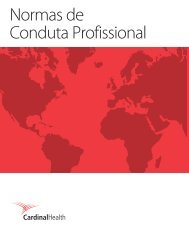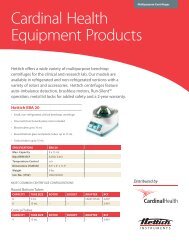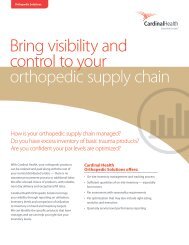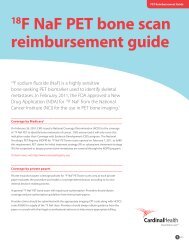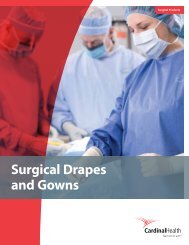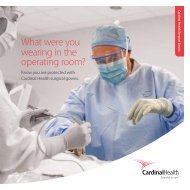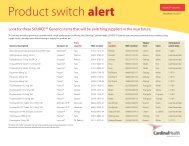FDA-approved radiopharmaceuticals - Cardinal Health
FDA-approved radiopharmaceuticals - Cardinal Health
FDA-approved radiopharmaceuticals - Cardinal Health
You also want an ePaper? Increase the reach of your titles
YUMPU automatically turns print PDFs into web optimized ePapers that Google loves.
Radiopharmaceutical Manufacturer Trade Names Approved Indications in Adults (Pediatric use as noted)<br />
1 Carbon-11 choline Mayo Clinic – Indicated for PET imaging of patients with suspected prostate cancer recurrence<br />
based upon elevated blood prostate specific antigen (PSA) levels following initial<br />
therapy and non-informative bone scintigraphy, computerized tomography (CT)<br />
or magnetic resonance imaging (MRI) to help identify potential sites of prostate<br />
cancer recurrence for subsequent histologic confirmation<br />
2 Carbon-14 urea Kimberly-Clark PYtest Detection of gastric urease as an aid in the diagnosis of H.pylori infection in<br />
the stomach<br />
3 Fluorine-18<br />
florbetapir<br />
4 Fluorine-18<br />
sodium fluoride 1<br />
5 Fluorine-18<br />
fludeoxyglucose 1<br />
Note: See page six for footnotes<br />
Eli Lilly Amyvid<br />
Various – PET bone imaging agent to delineate<br />
areas of altered osteogenesis<br />
Radiopharmaceuticals that may potentially have un<strong>approved</strong> copies of <strong>FDA</strong><strong>approved</strong><br />
commercially available <strong>radiopharmaceuticals</strong> in the marketplace.<br />
<strong>FDA</strong>-<strong>approved</strong> <strong>radiopharmaceuticals</strong><br />
<strong>FDA</strong>-<strong>approved</strong><br />
<strong>radiopharmaceuticals</strong><br />
This is a current list of all <strong>FDA</strong><strong>approved</strong><br />
<strong>radiopharmaceuticals</strong>.<br />
Nuclear medicine practitioners that<br />
receive <strong>radiopharmaceuticals</strong> that<br />
originate from sources other than the<br />
manufacturers listed in these tables<br />
may be using un<strong>approved</strong> copies.<br />
Various – As a PET imaging agent to:<br />
• Assess abnormal glucose metabolism in oncology<br />
• Assess myocardial hibernation<br />
• Identify regions of abnormal glucose metabolism associated with foci of<br />
epileptic seizures<br />
Rev. 7 | 12.04.12<br />
1<br />
of 6
Radiopharmaceutical Manufacturer Trade Names Approved Indications in Adults (Pediatric use as noted)<br />
6 Gallium-67 citrate Covidien – Useful to demonstrate the presence/extent of:<br />
7 Indium-111<br />
capromab pendetide<br />
Lantheus<br />
Medical Imaging<br />
Radiopharmaceuticals that may potentially have un<strong>approved</strong> copies of <strong>FDA</strong><strong>approved</strong><br />
commercially available <strong>radiopharmaceuticals</strong> in the marketplace.<br />
–<br />
• Hodgkin’s disease<br />
• Lymphoma<br />
• Bronchogenic carcinoma<br />
Aid in detecting some acute inflammatory lesions<br />
EUSA Pharma ProstaScint® • A diagnostic imaging agent in newly-diagnosed patients with biopsy-proven<br />
prostate cancer, thought to be clinically-localized after standard diagnostic<br />
evaluation (e.g. chest x-ray, bone scan, CT scan, or MRI), who are at high-risk for<br />
pelvic lymph node metastases<br />
• A diagnostic imaging agent in post-prostatectomy patients with a rising PSA<br />
and a negative or equivocal standard metastatic evaluation in whom there is a<br />
high clinical suspicion of occult metastatic disease<br />
8 Indium-111 chloride Covidien – Indicated for radiolabeling:<br />
• ProstaScint® used for in vivo diagnostic imaging procedures<br />
GE <strong>Health</strong>care Indiclor<br />
9 Indium-111 pentetate GE <strong>Health</strong>care – For use in radionuclide cisternography<br />
10 Indium-111<br />
oxyquinoline<br />
11 Indium-111<br />
pentetreotide<br />
12 Iodine I-123<br />
iobenguane<br />
GE <strong>Health</strong>care – Indicated for radiolabeling autologous leukocytes which may be used as an<br />
adjunct in the detection of inflammatory processes to which leukocytes migrate,<br />
such as those associated with abscesses or other infection<br />
Covidien Octreoscan An agent for the scintigraphic localization of primary<br />
and metastatic neuroendocrine tumors bearing somatostatin receptors<br />
GE <strong>Health</strong>care AdreView In patients > 1 month of age as an adjunct to other diagnostic tests, detection of<br />
primary or metastatic:<br />
• Pheochromocytoma<br />
• Neuroblastoma<br />
13 Iodine I-123 ioflupane 2 GE <strong>Health</strong>care DaTscan Indicated for striatal dopamine transporter visualization using SPECT brain<br />
imaging to assist in the evaluation of adult patients with suspected Parkinsonian<br />
syndromes (PS) in whom it may help differentiate essential tremor due to<br />
PS (idiopathic Parkinson’s disease, multiple system atrophy and progressive<br />
supranuclear palsy)<br />
14 Iodine I-123<br />
sodium iodide capsules<br />
15 Iodine I-125 human<br />
serum albumin<br />
16 Iodine I-125<br />
iothalamate<br />
Note: See page six for footnotes<br />
<strong>Cardinal</strong> <strong>Health</strong> – Indicated for use in the evaluation of thyroid:<br />
Covidien –<br />
• Function<br />
• Morphology<br />
IsoTex<br />
Diagnostics<br />
IsoTex<br />
Diagnostics<br />
Jeanatope Indicated for use in the determination of:<br />
• Total blood<br />
• Plasma volume<br />
Glofil-125 Indicated for evaluation of glomerular filtration<br />
Rev. 7 | 12.04.12<br />
2<br />
of 6
Radiopharmaceutical Manufacturer Trade Names Approved Indications in Adults (Pediatric use as noted)<br />
17 Iodine I-131 human<br />
serum albumin<br />
18 Iodine I-131<br />
sodium iodide<br />
19 Iodine I-131<br />
tositumomab<br />
20 Molybdenum<br />
Mo-99 generator<br />
IsoTex<br />
Diagnostics<br />
Megatope Indicated for use in determinations of:<br />
• Total blood and plasma volumes<br />
• Cardiac output<br />
• Cardiac and pulmonary blood volumes<br />
and circulation times<br />
• Protein turnover studies<br />
• Heart and great vessel delineation<br />
• Localization of the placenta<br />
• Localization of cerebral neoplasms<br />
Covidien – Diagnostic:<br />
DRAXIMAGE HICON • Performance of the radioactive iodide (RAI)<br />
uptake test to evaluate thyroid function<br />
• Localizing metastases associated with thyroid malignancies<br />
Therapeutic:<br />
• Treatment of hyperthyroidism<br />
• Treatment of carcinoma of the thyroid<br />
GlaxoSmithKline BEXXAR® Indicated for:<br />
Treatment of patients with CD20 antigen-expressing relapsed or refractory, low<br />
grade, follicular, or transformed non-Hodgkin’s lymphoma, including patients with<br />
Rituximab-refractory non-Hodgkin’s lymphoma<br />
Covidien Ultra-<br />
TechneKow®<br />
DTE<br />
Lantheus<br />
Medical Imaging<br />
Technelite®<br />
Radiopharmaceuticals that may potentially have un<strong>approved</strong> copies of <strong>FDA</strong><strong>approved</strong><br />
commercially available <strong>radiopharmaceuticals</strong> in the marketplace.<br />
Generation of Tc-99m sodium pertechnetate for administration or<br />
radiopharmaceutical preparation<br />
21 Nitrogen-13 ammonia 1 Various – PET agent used for evaluation of myocardial<br />
blood flow (perfusion)<br />
22 Rubidium-82 chloride Bracco<br />
Diagnostics<br />
23 Samarium-153<br />
lexidronam<br />
Cardiogen-82® PET myocardial perfusion agent that is useful in distinguishing normal from<br />
abnormal myocardium in patients with suspected myocardial infarction<br />
EUSA Pharma Quadramet® Indicated for relief of pain in patients with confirmed osteoblastic metastatic<br />
bone lesions that enhance on radionuclide bone scan<br />
24 Strontium-89 chloride Bio-Nucleonics – Indicated for the relief of bone pain in patients with painful skeletal metastases<br />
that have been confirmed prior to therapy<br />
GE <strong>Health</strong>care Metastron<br />
25 Technetium-99m<br />
bicisate<br />
26 Technetium-99m<br />
disofenin<br />
27 Technetium-99m<br />
exametazine<br />
28 Technetium-99m<br />
macroaggregated<br />
albumin<br />
Note: See page six for footnotes<br />
Lantheus<br />
Medical Imaging<br />
Neurolite® SPECT imaging as an adjunct to conventional CT or MRI imaging in the<br />
localization of stroke in patients in whom stroke has already been diagnosed<br />
Pharmalucence Hepatolite® Diagnosis of acute cholecystitis as well as to rule out the occurrence of acute<br />
cholecystitis in suspected patients with right upper quadrant pain, fever,<br />
jaundice, right upper quadrant tenderness and mass or rebound tenderness, but<br />
not limited to these signs and symptoms.<br />
GE <strong>Health</strong>care Ceretec • As an adjunct in the detection of altered regional cerebral perfusion in stroke<br />
• Leukocyte labeled scintigraphy as an adjunct in the localization of intra<br />
abdominal infection and inflammatory bowel disease<br />
DRAXIMAGE – • An adjunct in the evaluation of pulmonary perfusion (adult and pediatric)<br />
• Evaluation of peritoneo-venous (LaVeen) shunt patency<br />
Rev. 7 | 12.04.12<br />
3<br />
of 6
Radiopharmaceutical Manufacturer Trade Names Approved Indications in Adults (Pediatric use as noted)<br />
29 Technetium-99m<br />
mebrofenin<br />
30 Technetium-99m<br />
medronate<br />
31 Technetium-99m<br />
mertiatide<br />
32 Technetium-99m<br />
oxidronate<br />
33 Technetium-99m<br />
pentetate<br />
34 Technetium-99m<br />
pyrophosphate<br />
35 Technetium-99m red<br />
blood cells<br />
36 Technetium-99m<br />
sestamibi<br />
Note: See page six for footnotes<br />
Bracco<br />
Diagnostics<br />
Pharmalucence –<br />
Bracco<br />
Diagnostics<br />
DRAXIMAGE –<br />
DRAXIMAGE MDP-25<br />
GE <strong>Health</strong>care MDP Multidose<br />
Pharmalucence –<br />
Covidien Technescan<br />
MAG3<br />
Covidien Technescan<br />
HDP<br />
Choletec® As a hepatobiliary imaging agent<br />
Radiopharmaceuticals that may potentially have un<strong>approved</strong> copies of <strong>FDA</strong><strong>approved</strong><br />
commercially available <strong>radiopharmaceuticals</strong> in the marketplace.<br />
MDP-Bracco As a bone imaging agent to delineate areas of altered osteogenesis<br />
In patients > 30 days of age as a renal imaging agent for use in the diagnosis of:<br />
• Congenital and acquired abnormalities<br />
• Renal failure<br />
• Urinary tract obstruction and calculi<br />
Diagnostic aid in providing:<br />
• Renal function<br />
• Split function<br />
• Renal angiograms<br />
• Renogram curves for whole kidney and renal cortex<br />
As a bone imaging agent to delineate areas of altered osteogenesis<br />
(adult and pediatric use)<br />
DRAXIMAGE – • Brain imaging<br />
• Kidney imaging:<br />
- To assess renal perfusion<br />
- To estimate glomerular filtration rate<br />
Covidien Technescan<br />
PYP<br />
Pharmalucence –<br />
• As a bone imaging agent to delineate areas of altered osteogenesis<br />
• As a cardiac imaging agent used as an adjunct in the diagnosis of acute<br />
myocardial infarction<br />
• As a blood pool imaging agent useful for:<br />
- Gated blood pool imaging<br />
- Detection of sites of gastrointestinal bleeding<br />
Covidien UltraTag Tc99m-labeled red blood cells are used for:<br />
• Blood pool imaging including cardiac first pass and gated equilibrium imaging<br />
• Detection of sites of gastrointestinal bleeding<br />
<strong>Cardinal</strong> <strong>Health</strong> – Myocardial perfusion agent that is indicated for:<br />
Covidien –<br />
DRAXIMAGE –<br />
Lantheus<br />
Medical Imaging<br />
Pharmalucence –<br />
Cardiolite®<br />
• Detecting coronary artery disease by localizing myocardial ischemia (reversible<br />
defects) and infarction (non-reversible defects)<br />
• Evaluating myocardial function<br />
• Developing information for use in patient<br />
management decisions<br />
Planar breast imaging as a second line diagnostic drug after mammography<br />
to assist in the evaluation of breast lesions in patients with an abnormal<br />
mammogram or a palpable breast mass<br />
Rev. 7 | 12.04.12<br />
4<br />
of 6
Radiopharmaceutical Manufacturer Trade Names Approved Indications in Adults (Pediatric use as noted)<br />
37 Technetium-<br />
99m sodium<br />
pertechnetate<br />
38 Technetium-99m<br />
succimer<br />
39 Technetium-99m<br />
sulfur colloid<br />
40 Technetium-99m<br />
tetrofosmin<br />
41 Thallium-201<br />
chloride<br />
Covidien – • Brain Imaging (including cerebral radionuclide angiography)*<br />
Lantheus<br />
Medical Imaging<br />
Radiopharmaceuticals that may potentially have un<strong>approved</strong> copies of <strong>FDA</strong><strong>approved</strong><br />
commercially available <strong>radiopharmaceuticals</strong> in the marketplace.<br />
–<br />
• Thyroid Imaging*<br />
• Salivary Gland Imaging<br />
• Placenta Localization<br />
• Blood Pool Imaging (including radionuclide angiography)*<br />
• Urinary Bladder Imaging (direct isotopic cystography) for the detection<br />
of vesico-ureteral reflux*<br />
• Nasolacrimal Drainage System Imaging<br />
(*adult and pediatric use)<br />
GE <strong>Health</strong>care – An aid in the scintigraphic evaluation of renal parenchymal disorders<br />
Pharmalucence – • Imaging areas of functioning retriculoendothelial cells in the liver,<br />
spleen and bone marrow*<br />
• It is used orally for:<br />
- Esophageal transit studies*<br />
- Gastroesophageal reflux scintigraphy*<br />
- Detection of pulmonary aspiration of gastric contents*<br />
• Aid in the evaluation of peritoneo-venous (LeVeen) shunt patency<br />
• To assist in the localization of lymph nodes draining a primary tumor in<br />
patients with breast cancer or malignant melanoma when used with a<br />
hand-held gamma counter.<br />
(*adult and pediatric use)<br />
GE <strong>Health</strong>care Myoview Myocardial perfusion agent that is indicated for:<br />
• Detecting coronary artery disease by localizing myocardial ischemia (reversible<br />
defects) and infarction (non-reversible defects)<br />
• The assessment of left ventricular function<br />
(left ventricular ejection fraction and wall motion)<br />
Covidien – • Useful in myocardial perfusion imaging for the diagnosis and localization of<br />
GE <strong>Health</strong>care –<br />
Lantheus<br />
Medical Imaging<br />
42 Xenon-133 gas Lantheus<br />
Medical Imaging<br />
43 Yttrium-90<br />
chloride<br />
44 Yttrium-90<br />
ibritumomab tiuxetan<br />
Note: See page six for footnotes<br />
–<br />
myocardial infarction<br />
• As an adjunct in the diagnosis of ischemic heart disease (atherosclerotic<br />
coronary artery disease)<br />
• Localization of sites of parathyroid hyperactivity in patients with elevated<br />
serum calcium and parathyroid hormone levels<br />
– • The evaluation of pulmonary function<br />
and for imaging the lungs<br />
• Assessment of cerebral flow<br />
MDS Nordion – Indicated for radiolabeling:<br />
Eckert & Ziegler<br />
Nuclitec<br />
–<br />
• Zevalin® used for radioimmunotherapy procedures<br />
Spectrum<br />
Pharmaceuticals<br />
Zevalin® Indicated for the:<br />
• Treatment of relapsed or refractory, low-grade or follicular B-cell<br />
non-Hodgkin’s lymphoma (NHL)<br />
• Treatment of previously untreated follicular NHL in patients who<br />
achieve a partial or complete response to first-line chemotherapy<br />
Rev. 7 | 12.04.12<br />
5<br />
of 6
Package Inserts may be viewed at http://nps.cardinal.com/MSDSPI/Main.aspx<br />
1 Subsequent to promulgation of 21 C.F.R. Part 212, Current Good Manufacturing Practices (cGMP) for<br />
PET Radiopharmaceuticals, firms manufacturing and distributing this drug are required to submit<br />
either a NDA or an ANDA by June 12, 2012 and manufacture following cGMP Part 212 regulations as<br />
of December 11, 2011 for its continued distribution and sale.<br />
2 This is a Schedule II controlled substance under the Controlled Substances Act. A DEA license is<br />
required for handling or administering this controlled substance.<br />
Any reader of this document is cautioned that <strong>Cardinal</strong> <strong>Health</strong> makes no representation, guarantee,<br />
or warranty, express or implied as to the accuracy and appropriateness of the information contained<br />
in this document, and will bear no responsibility or liability for the results or consequences of its use.<br />
The information provided is for educational purposes only.<br />
© 2012 <strong>Cardinal</strong> <strong>Health</strong>. All rights reserved. <strong>Cardinal</strong> <strong>Health</strong>, the <strong>Cardinal</strong> <strong>Health</strong> Logo,<br />
and ESSENTIAL TO CARE are trademarks or registered trademarks of <strong>Cardinal</strong> <strong>Health</strong>.<br />
All other marks are the property of their respective owners. Lit. No. 7COMPLI10620 (12/2012)<br />
cardinalhealth.com<br />
<strong>Cardinal</strong> <strong>Health</strong><br />
7000 <strong>Cardinal</strong> Place<br />
Dublin, Ohio 43017<br />
Rev. 7 | 12.04.12<br />
6<br />
of 6
515844-0209 February 2009<br />
SESTAMIBI<br />
Kit for the Preparation of<br />
Technetium Tc99m Sestamibi for Injection<br />
FOR DIAGNOSTIC USE<br />
hIGhLIGhTS of PReSCRIBING INfoRmaTIoN<br />
These highlights do not include all the information needed to use Technetium<br />
Tc99m Sestamibi safely and effectively. See full prescribing information for<br />
Technetium Tc99m Sestamibi.<br />
31036<br />
Sestamibi, Kit for the Preparation of Technetium Tc99m Sestamibi for Injection<br />
Initial U.S. Approval: December, 1990<br />
-----------------------------------ReCeNT maJoR ChaNGeS--------------------------------<br />
Use in specific populations (8.3) 10/2007<br />
-----------------------------INDICaTIoNS aND USaGe---------------------------------<br />
Technetium Tc99m Sestamibi is a myocardial perfusion agent indicated for:<br />
• detecting coronary artery disease by localizing myocardial ischemia (reversible<br />
defects) and infarction (non-reversible defects)<br />
• evaluating myocardial function and developing information for use in patient<br />
management decisions<br />
------------------------------DoSaGe aND aDmINISTRaTIoN-----------------------------<br />
• For Myocardial Imaging: The suggested dose range for I.V. administration of<br />
Technetium Tc99m Sestamibi in a single dose to be employed in the average<br />
patient (70 Kg) is 370-1110 MBq (10-30 mCi).<br />
• For Breast Imaging: The recommended dose range for I.V. administration of<br />
Technetium Tc99m Sestamibi is a single dose of 740-1110 MBq (20 - 30 mCi).<br />
----------------------------DoSaGe foRmS aND STReNGThS----------------------------<br />
• Technetium Tc99m Sestamibi is supplied as a 5mL vial in a kit of twenty (20) (NDC<br />
# 65857-600-20), sterile and non-pyrogenic.<br />
• Prior to lyophilization the pH is between 5.3-5.9. The contents of the vial<br />
are lyophilized and stored under nitrogen. Store at 15-25°C before and after<br />
reconstitution.<br />
------------------------------------CoNTRaINDICaTIoNS------------------------------------<br />
• None known<br />
-------------------------------WaRNINGS aND PReCaUTIoNS------------------------------<br />
• Pharmacologic induction of cardiovascular stress may be associated with<br />
serious adverse events such as myocardial infarction, arrhythmia, hypotension,<br />
bronchoconstriction and cerebrovascular events.<br />
• Technetium Tc99m Sestamibi has been rarely associated with acute severe allergic<br />
and anaphylactic events of angioedema and generalized urticaria. In some<br />
patients the allergic symptoms developed on the second injection during<br />
Technetium Tc99m Sestamibi imaging.<br />
• Caution should be exercised and emergency equipment should be available when<br />
administering Technetium Tc99m Sestamibi.<br />
• Before administering Technetium Tc99m Sestamibi patients should be asked<br />
about the possibility of allergic reactions to the drug.<br />
• The contents of the vial are intended only for use in the preparation of Technetium<br />
Tc99m Sestamibi and are not to be administered directly to the patient without<br />
first undergoing the preparative procedure.<br />
-----------------------------------aDVeRSe ReaCTIoNS-------------------------------------<br />
• The following adverse reactions have been reported in ≤ 0.5% of patients: signs<br />
and symptoms consistent with seizure occurring shortly after administration of the<br />
agent; transient arthritis, angioedema, arrythmia, dizziness, syncope, abdominal<br />
pain, vomiting, and severe hypersensitivity characterized by dyspnea, hypotension,<br />
bradycardia, asthenia, and vomiting within two hours after a second injection<br />
of Technetium Tc99m Sestamibi. A few cases of flushing, edema, injection site<br />
inflammation, dry mouth, fever, pruritis, rash, urticaria and fatigue have also been<br />
attributed to administration of the agent.<br />
To report SUSPeCTeD aDVeRSe ReaCTIoNS, contact <strong>Cardinal</strong> health at<br />
1-800-539-1503 or fDa at 1-800-fDa-1088<br />
www.fda.gov/medwatch.<br />
------------------------------------DRUG INTeRaCTIoNS-------------------------------------<br />
• Specific drug-drug interactions have not been studied.<br />
-------------------------------USe IN SPeCIfIC PoPULaTIoNS-----------------------------<br />
• In one study of 46 subjects who received Technetium Tc99m Sestamibi<br />
administration, the radioactivity in both children and adolescents exhibited blood PK<br />
profiles similar to those previously reported in adults.<br />
See 17 for PaTIeNT CoUNSeLING INfoRmaTIoN<br />
Revised: february 2009<br />
515844-0209<br />
fULL PReSCRIBING INfoRmaTIoN: CoNTeNTS*<br />
1. INDICATIONS AND USAGE<br />
2. DOSAGE AND ADMINISTRATION<br />
2.1 IMAGE ACqUISITION<br />
2.2 RADIATION DOSIMETRY<br />
2.3 INSTRUCTIONS FOR PREPARATION<br />
2.4 DETERMINATION OF RADIOCHEMICAL PURITY IN TECHNETIUM<br />
TC99M SESTAMIBI<br />
3. DOSAGE FORMS AND STRENGTHS<br />
4. CONTRAINDICATIONS<br />
5. WARNINGS AND PRECAUTIONS<br />
5.1 WARNINGS<br />
5.2 GENERAL PRECAUTIONS<br />
6. ADVERSE REACTIONS<br />
7. DRUG INTERACTIONS<br />
8. USE IN SPECIFIC PATIENTS<br />
8.1 PREGNANCY CATEGORY C<br />
8.2 NURSING MOTHERS<br />
8.3 PEDIATRIC USE<br />
8.4 GERIATRIC USE<br />
9. DRUG ABUSE AND DEPENDENCE<br />
9.1 CONTROLLED SUBSTANCE<br />
9.2 ABUSE<br />
9.3 DEPENDENCE<br />
10. OVERDOSAGE<br />
11. DESCRIPTION<br />
11.1 PHYSICAL CHARACTERISTICS<br />
11.2 EXTERNAL RADIATION<br />
12. CLINICAL PHARMACOLOGY<br />
12.1 GENERAL<br />
12.2 PHARMACOKINETICS<br />
12.3 METABOLISM<br />
12.4 ELIMINATION<br />
13. NONCLINICAL TOXICOLOGY<br />
13.1 CARCINOGENESIS, MUTAGENESIS, IMPAIRMENT OF FERTILITY<br />
14. CLINICAL STUDIES<br />
15. REFERENCES<br />
16. HOW SUPPLIED/STORAGE AND HANDLING<br />
17. PATIENT COUNSELING INFORMATION<br />
*SECTIONS OR SUBSECTIONS OMITTED FROM THE FULL PRESCRIBING<br />
INFORMATION ARE NOT LISTED.<br />
1. INDICaTIoNS aND USaGe<br />
Myocardial Imaging: Sestamibi, Kit for the Preparation of Technetium Tc99m<br />
Sestamibi for Injection, is a myocardial perfusion agent that is indicated for detecting<br />
coronary artery disease by localizing myocardial ischemia (reversible defects) and<br />
infarction (non-reversible defects), in evaluating myocardial function and developing<br />
information for use in patient management decisions. Technetium Tc99m Sestamibi<br />
evaluation of myocardial ischemia can be accomplished with rest and cardiovascular<br />
stress techniques (e.g., exercise or pharmacologic stress in accordance with the<br />
pharmacologic stress agent’s labeling).<br />
It is usually not possible to determine the age of a myocardial infarction or to<br />
differentiate a recent myocardial infarction from ischemia.<br />
Breast Imaging: Sestamibi, Kit for the Preparation of Technetium Tc99m Sestamibi<br />
for Injection, is indicated for planar imaging as a second line diagnostic drug after<br />
mammography to assist in the evaluation of breast lesions in patients with an<br />
abnormal mammogram or a palpable breast mass.<br />
Technetium Tc99m Sestamibi is not indicated for breast cancer screening, to confirm<br />
the presence or absence of malignancy, and it is not an alternative to biopsy.<br />
2. DoSaGe aND aDmINISTRaTIoN<br />
For Myocardial Imaging: The suggested dose range for I.V. administration of<br />
Technetium Tc99m Sestamibi in a single dose to be employed in the average patient<br />
(70 Kg) is 370-1110 MBq (10-30 mCi).<br />
For Breast Imaging: The recommended dose range for I.V. administration of<br />
Technetium Tc99m Sestamibi is a single dose of 740-1110 MBq (20 - 30 mCi).<br />
2.1 Image acquisition<br />
Breast Imaging: It is recommended that images are obtained with a table overlay to<br />
separate breast tissue from the myocardium and liver, and to exclude potential activity<br />
that may be present in the opposite breast. For lateral images, position the patient<br />
prone with the isolateral arm comfortably above the head, shoulders flat against the<br />
table, head turned to the side and relaxed, with the breast imaged pendent through<br />
an overlay cutout. The breast should not be compressed on the overlay. For anterior<br />
images, position the patient supine with both arms behind the head. For either lateral<br />
or anterior images, shield the chest and abdominal organs, or remove them from<br />
the field of view.<br />
For complete study, sets of images should be obtained five minutes after the injection,<br />
and in the following sequence:<br />
Beginning five minutes after the injection of Technetium Tc99m Sestamibi:<br />
• ten-minute lateral image of breast with abnormality<br />
• ten-minute lateral image of contralateral breast<br />
• ten-minute anterior image of both breasts<br />
Table 1.0. Radiation absorbed Doses from Tc99m Sestamibi<br />
Estimated Radiation Absorbed Dose<br />
REST<br />
2.0 hour void 4.8 hour void<br />
rads/ mGy/ rads/ mGy/<br />
Organ 30 mCi 1110 MBq 30 mCi 1110 MBq<br />
Breasts 0.2 2.0 0.2 1.9<br />
Gallbladder Wall 2.0 20.0 2.0 2 0.0<br />
Small Intestine 3.0 30.0 3.0 30.0<br />
Upper Large Intestine<br />
Wall 5.4 55.5 5.4 55.5<br />
Lower Large Intestine<br />
Wall 3.9 40.0 4.2 41.1<br />
Stomach Wall 0.6 6.1 0.6 5.8<br />
Heart Wall 0.5 5.1 0.5 4.9<br />
Kidneys 2.0 20.0 2.0 20.0<br />
Liver 0.6 5.8 0.6 5.7<br />
Lungs 0.3 2.8 0.3 2.7<br />
Bone Surfaces 0.7 6.8 0.7 6.4<br />
Thyroid 0.7 7.0 0.7 2.4<br />
Ovaries 1.5 15.5 1.6 15.5<br />
Testes 0.3 3.4 0.4 3.9<br />
Red Marrow 0.5 5.1 0.5 5.0<br />
Urinary Bladder Wall 2.0 20.0 4.2 41.1<br />
Total Body 0.5 4.8 0.5 4.8<br />
2.0 hour void<br />
STRESS<br />
4.8 hour void<br />
rads/ mGy/ rads/ mGy/<br />
Organ 30 mCi 1110 MBq 30 mCi 1110 MBq<br />
Breasts 0.2 2.0 0.2 1.8<br />
Gallbladder Wall 2.8 28.9 2.8 27.8<br />
Small Intestine<br />
Upper Large Intestine<br />
2.4 24.4 2.4 24.4<br />
Wall<br />
Lower Large Intestine<br />
4.5 44.4 4.5 44.4<br />
Wall 3.3 32.2 3.3 32.2<br />
Stomach Wall 0.6 5.3 0.5 5.2<br />
Heart Wall 0.5 5.6 0.5 5.3<br />
Kidneys 1.7 16.7 1.7 16.7<br />
Liver 0.4 4.2 0.4 4.1<br />
Lungs 0.3 2.6 0.2 2.4<br />
Bone Surfaces 0.6 6.2 0.6 6.0<br />
Thyroid 0.3 2.7 0.2 2.4<br />
Ovaries 1.2 12.2 1.3 13.3<br />
Testes 0.3 3.1 0.3 3.4<br />
Red Marrow 0.5 4.6 0.5 4.4<br />
Urinary Bladder Wall 1.5 15.5 3.0 30.0<br />
Total Body 0.4 4.2 0.4 4.2<br />
Radiation dosimetry calculations performed by Radiation Internal Dose Information<br />
Center, Oak Ridge Institute for Science and Education, PO Box 117, Oak Ridge, TN<br />
37831-0117, (865) 576-3448.<br />
2.3 Instructions for Preparation<br />
Preparation of the Technetium Tc99m Sestamibi from the Kit for the Preparation of<br />
Technetium Tc99m Sestamibi is done by the following aseptic procedure:<br />
General Procedure:<br />
a. Prior to adding the Sodium Pertechnetate Tc99m Injection to the vial, inspect the<br />
vial carefully for the presence of damage, particularly cracks, and do not use the<br />
vial if found. Tear off a radiation symbol and attach it to the neck of the vial.<br />
b. Waterproof gloves should be worn during the preparation procedure.<br />
Remove the plastic disc from the vial and swab the top of the vial closure<br />
with alcohol to sanitize the surface.<br />
Boiling Water Bath Procedure:<br />
c. Place the vial in a suitable radiation shield with a fitted radiation cap.<br />
d. With a sterile shielded syringe, aseptically obtain additive-free, sterile, nonpyrogenic<br />
Sodium Pertechnetate Tc99m Injection [925-5550 MBq, (25-150<br />
mCi)] in approximately 1 to 3 mL.<br />
e. Aseptically add the Sodium Pertechnetate Tc99m Injection to the vial in the<br />
lead shield. Without withdrawing the needle, remove an equal volume of<br />
headspace to maintain atmospheric pressure within the vial.<br />
f. Shake vigorously, about 5 to 10 quick upward-downward motions.<br />
g. Remove the vial from the lead shield and place upright in an appropriately<br />
shielded and contained boiling water bath, such that the vial is suspended<br />
above the bottom of the bath, and boil for 10 minutes. Timing for 10 minutes<br />
is begun as soon as the water begins to boil again. Do not allow the boiling<br />
water to come in contact with the aluminum crimp.<br />
h. Remove the vial from the water bath, place in the lead shield and allow to cool<br />
for fifteen minutes.<br />
Recon-o-Stat (thermal cycler) Procedure:<br />
c. Place the vial in the thermal cycler radiation shield.<br />
d. With a sterile shielded syringe, aseptically obtain additive-free, sterile,<br />
non-pyrogenic Sodium Pertechnetate Tc99m Injection [925-5550 MBq,<br />
(25-150 mCi)] in approximately 1 to 3 mL.<br />
e. Aseptically add the Sodium Pertechnetate Tc99m Injection to the vial in the<br />
lead shield. Without withdrawing the needle, remove an equal volume of<br />
headspace to maintain atmospheric pressure within the vial.<br />
General Procedure (cont.):<br />
f. Shake vigorously, about 5 to 10 quick upward-downward motions.<br />
g. Place shield on sample block. While slightly pressing downward, give the<br />
shield a quarter turn to make certain there is a firm fit between the shield and<br />
the sample block.<br />
h. Press the proceed button to initiate the program (the thermal cycler<br />
automatically heats & cools the vial and contents). Please see the Recon-o-<br />
Stat Instruction Manual for further details.<br />
i. Using proper shielding, the vial contents should be visually inspected. Use<br />
only if the solution is clear and free of particulate matter and discoloration.<br />
j. Assay the reaction vial using a suitable radioactivity calibration system.<br />
Record the Technetium Tc99m concentration, total volume, assay time and<br />
date, expiration time and lot number on the vial shield label and affix the label<br />
to the shield.<br />
k. Store the reaction vial containing the Technetium Tc99m Sestamibi at 15°<br />
to 25°C until use; at such time the product should be aseptically withdrawn.<br />
Technetium Tc99m Sestamibi should be used within six hours of preparation.<br />
The vial contains no preservative.<br />
Note: Adherence to the above product reconstitution instructions is recommended.<br />
The potential for cracking and significant contamination exists whenever<br />
vials containing radioactive material are heated.<br />
Product should be used within 6 hours after preparation.<br />
Final product with radiochemical purity of at least 90% was used in the<br />
clinical trials that established safety and effectiveness. The radiochemical<br />
purity was determined by the following method.<br />
2.4 Determination of Radiochemical Purity in Technetium Tc99m Sestamibi<br />
1. Obtain a Baker-Flex Aluminum Oxide coated, plastic TLC plate, #1 B-F, pre-cut<br />
to 2.5 cm x 7.5 cm.<br />
2. Dry the plate or plates at 100°C for 1 hour and store in a desiccator. Remove<br />
pre-dried plate from the desiccator just prior to use.<br />
3. Apply 1 drop of ethanol* using a 1 mL syringe with a 22-26 gauge needle, 1.5 cm<br />
from the bottom of the plate. THE SPOT SHOULD NOT BE ALLOWED TO DRY.<br />
4. Add 2 drops of Technetium Tc99m Sestamibi solution, side by side on top of<br />
the ethanol* spot. Return the plate to a desiccator and allow the sample spot<br />
to dry (typically 15 minutes).<br />
5. The TLC tank is prepared by pouring ethanol* to a depth of 3-4 mm. Cover<br />
the tank and let it equilibrate for ~10 minutes.<br />
6. Develop the plate in the covered TLC tank in ethanol* for a distance of 5 cm<br />
from the point of application.<br />
7. Cut the TLC plate 4 cm from the bottom and measure the Tc99m activity in<br />
each piece by appropriate radiation detector.<br />
8. Calculate the % Tc99m Sestamibi as:<br />
TLC Plate Diagram<br />
7.5 cm<br />
% Tc99m Sestamibi = µCi Top Piece X 100<br />
µCi Both Pieces<br />
1cm<br />
2.5 cm<br />
2.5 cm<br />
1.5 cm<br />
TOP<br />
SOLVENT<br />
FRONT<br />
CUT HERE<br />
ORIGIN<br />
BOTTOM<br />
*The ethanol used in this procedure should be 95% or greater. Absolute ethanol<br />
(99%) should remain at > 95% ethanol content for one week after opening if stored<br />
tightly capped, in a cool dry place.<br />
3. DoSaGe foRmS aND STReNGThS<br />
Sestamibi, Kit for the Preparation of Technetium Tc99m Sestamibi for Injection is<br />
supplied as a 5mL vial in a kit of twenty (20) (NDC # 65857-600-20), sterile and<br />
non-pyrogenic.<br />
Prior to lyophilization the pH is between 5.3-5.9. The contents of the vial are lyophilized<br />
and stored under nitrogen. Store at 15-25°C before and after reconstitution.<br />
Technetium Tc99m Sestamibi contains no preservatives. Included in each two (2)<br />
vial kit is one (1) package insert, six (6) vial shield labels and six (6) radiation warning<br />
labels. Included in each five (5) vial kit is one (1) package insert, six (6) vial shield<br />
labels and six (6) radiation warning labels. Included in each twenty (20) vial kit is one<br />
(1) package insert, twenty four (24) vial shield labels and twenty four (24) radiation<br />
warning labels.<br />
This reagent kit is <strong>approved</strong> for distribution to persons licensed pursuant to the Code<br />
of Massachusetts Regulations 105 CMR 120.500 for the uses listed in 105 CMR<br />
120.547 or 120.552, or under equivalent regulations of the U.S. Nuclear Regulatory<br />
Commission, Agreement States or Licensing States.<br />
4. CoNTRaINDICaTIoNS<br />
None known.<br />
5. WaRNINGS aND PReCaUTIoNS<br />
5.1 Warnings<br />
In studying patients in whom cardiac disease is known or suspected, care should be<br />
taken to assure continuous monitoring and treatment in accordance with safe, accepted<br />
clinical procedure. Infrequently, death has occurred 4 to 24 hours after Tc99m Sestamibi<br />
use and is usually associated with exercise stress testing (See Precautions).<br />
Pharmacologic induction of cardiovascular stress may be associated with serious adverse<br />
events such as myocardial infarction, arrhythmia, hypotension, bronchoconstriction and<br />
cerebrovascular events. Caution should be used when pharmacologic stress is selected<br />
as an alternative to exercise; it should be used when indicated and in accordance with<br />
the pharmacologic stress agent’s labeling.<br />
Technetium Tc99m Sestamibi has been rarely associated with acute severe allergic<br />
and anaphylactic events of angioedema and generalized urticaria. In some patients<br />
the allergic symptoms developed on the second injection during Technetium Tc99m<br />
Sestamibi imaging. Caution should be exercised and emergency equipment should be<br />
available when administering Technetium Tc99m Sestamibi. Also, before administering<br />
Technetium Tc99m Sestamibi patients should be asked about the possibility of allergic<br />
reactions to the drug.<br />
5.2 General Precautions<br />
The contents of the vial are intended only for use in the preparation of Technetium<br />
Tc99m Sestamibi and are not to be administered directly to the patient without first<br />
undergoing the preparative procedure.<br />
Radioactive drugs must be handled with care and appropriate safety measures<br />
should be used to minimize radiation exposure to clinical personnel. Also, care<br />
should be taken to minimize radiation exposure to the patients consistent with proper<br />
patient management.<br />
Contents of the kit before preparation are not radioactive. However, after the Sodium<br />
Pertechnetate Tc99m Injection is added, adequate shielding of the final preparation<br />
must be maintained. The components of the kit are sterile and non-pyrogenic. It<br />
is essential to follow directions carefully and to adhere to strict aseptic procedures<br />
during preparation.<br />
Technetium Tc99m labeling reactions depend on maintaining the stannous ion in the<br />
reduced state. Hence, Sodium Pertechnetate Tc99m Injection containing oxidants<br />
should not be used.<br />
Technetium Tc99m Sestamibi should not be used more than six hours after<br />
preparation.<br />
Radiopharmaceuticals should be used only by physicians who are qualified by<br />
training and experience in the safe use and handling of radionuclides and whose<br />
experience and training have been <strong>approved</strong> by the appropriate government agency<br />
authorized to license the use of radionuclides.<br />
Stress testing should be performed only under the supervision of a qualified<br />
physician and in a laboratory equipped with appropriate resuscitation and support<br />
apparatus.<br />
The most frequent exercise stress test endpoints sufficient to stop the test reported<br />
during controlled studies (two-thirds were cardiac patients) were:<br />
Fatigue 35%<br />
Dyspnea 17%<br />
Chest Pain 16%<br />
ST-depression 7%<br />
Arrhythmia 1%<br />
6. aDVeRSe ReaCTIoNS<br />
Adverse events were evaluated in 3741 adults who were evaluated in clinical studies.<br />
Of these patients, 3068 (77% men, 22% women, and 0.7% of the patient’s genders<br />
were not recorded) were in cardiac clinical trials and 673 (100% women) in breast<br />
imaging trials. Cases of angina, chest pain, and death have occurred (see Warnings<br />
and Precautions). Adverse events reported at a rate of 0.5% or greater after receiving<br />
Technetium Tc99m Sestamibi administration are shown in the following table:<br />
Table 2.0<br />
Selected adverse events Reported in > 0.5% of Patients Who Received<br />
Technetium Tc99m Sestamibi in either Breast or Cardiac Clinical Studies*<br />
Body System Breast Studies Cardiac Studies<br />
Women Women Men<br />
Total<br />
n = 673 n = 685 n = 2361 n = 3046<br />
Body as a Whole 21 (3.1%) 6 (0.9%) 17 (0.7%) 23 (0.8%)<br />
Headache 11 (1.6%) 2 (0.3%) 4 (0.2%) 6 (0.2%)<br />
Cardiovascular 9 (1.3%) 24 (3.5%) 75 (3.2%) 99 (3.3%)<br />
Chest Pain/Angina 0 (0%) 18 (2.6%) 46 (1.9%) 64 (2.1%)<br />
ST segment changes 0 (0%) 11 (1.6%) 29 (1.2%) 40 (1.3%)<br />
Digestive System 8 (1.2%) 4 (0.6%) 9 (0.4%) 13 (0.4%)<br />
Nausea 4 (0.6%) 1 (0.1%) 2 (0.1%) 3 (0.1%)<br />
Special Senses 132 (19.6%) 62 (9.1%) 160 (6.8%) 222 (7.3%)<br />
Taste Perversion 129 (19.2%) 60 (8.8%) 157 (6.6%) 217 (7.1%)<br />
Parosmia 8 (1.2%) 6 (0.9%) 10 (0.4%) 16 (0.5%)<br />
*Excludes the 22 patients whose gender were not recorded.<br />
In the clinical studies for breast imaging, breast pain was reported in 12 (1.7%) of<br />
the patients. In 11 of these patients the pain appears to be associated with biopsy/<br />
surgical procedures.<br />
The following adverse reactions have been reported in ≤ 0.5% of patients: signs<br />
and symptoms consistent with seizure occurring shortly after administration of the<br />
agent; transient arthritis, angioedema, arrythmia, dizziness, syncope, abdominal
pain, vomiting, and severe hypersensitivity characterized by dyspnea, hypotension,<br />
bradycardia, asthenia, and vomiting within two hours after a second injection of<br />
Technetium Tc99m Sestamibi. A few cases of flushing, edema, injection site<br />
inflammation, dry mouth, fever, pruritis, rash, urticaria and fatigue have also been<br />
attributed to administration of the agent.<br />
7. DRUG INTeRaCTIoNS<br />
Specific drug-drug interactions have not been studied.<br />
8. USe IN SPeCIfIC PaTIeNTS<br />
8.1 Pregnancy Category C<br />
Animal reproduction and teratogenicity studies have not been conducted with<br />
Technetium Tc99m Sestamibi. It is also not known whether Technetium Tc99m<br />
Sestamibi can cause fetal harm when administered to a pregnant woman or can affect<br />
reproductive capacity. There have been no studies in pregnant women. Technetium<br />
Tc99m Sestamibi should be given to a pregnant woman only if clearly needed.<br />
8.2 Nursing mothers<br />
Technetium Tc99m Pertechnetate is excreted in human milk during lactation. It is not<br />
known whether Technetium Tc99m Sestamibi is excreted in human milk. Therefore,<br />
formula feedings should be substituted for breast feedings.<br />
8.3 Pediatric Use<br />
Safety and effectiveness in the pediatric population have not been established.<br />
No evidence of diagnostic efficacy or clinical utility of Technetium Tc99m Sestamibi<br />
scan was found in clinical studies of children and adolescents with Kawasaki disease.<br />
A prospective study of 445 pediatric patients with Kawasaki disease was designed<br />
to determine the predictive value of Technetium Tc99m Sestamibi rest and stress<br />
myocardial perfusion imaging to define a pediatric population with Kawasaki disease<br />
that was at risk of developing cardiac events. Cardiac events were defined as cardiac<br />
death, MI, hospitalization due to cardiac etiology, heart failure, CABG or coronary<br />
angioplasty. The standard of truth was defined as cardiac events occurring 6 months<br />
following the administration of Technetium Tc99m Sestamibi . Only three cardiac<br />
events were observed at six months in this study. In all three cases, the scan was<br />
negative. No clinically meaningful measurements of sensitivity, specificity or other<br />
diagnostic performance parameters could be demonstrated in this study.<br />
A ten year retrospective case history study of pediatric Kawasaki disease patients<br />
who completed Technetium Tc99m Sestamibi myocardial perfusion imaging and<br />
who had coronary angiography within three months of the Technetium Tc99m<br />
Sestamibi scan was designed to measure sensitivity and specificity of Technetium<br />
Tc99m Sestamibi scan. Out of 72 patients who had both evaluable Technetium<br />
Tc99m Sestamibi scans and evaluable angiographic images, only one patient had<br />
both an abnormal angiogram and an abnormal Technetium Tc99m Sestamibi scan.<br />
No clinically meaningful measurements of sensitivity, specificity or other diagnostic<br />
performance parameters could be demonstrated in this study.<br />
In a clinical pharmacology study, 46 pediatric patients with Kawasaki disease<br />
received Technetium Tc99m Sestamibi administration at the following doses: 0.1-0.2<br />
mCi/kg for rest, 0.3 mCi/kg for stress in one day studies; 0.2 mCi/kg for rest and 0.2<br />
mCi/kg for stress in two day studies.<br />
The radioactivity both in younger children and in adolescents exhibited PK profiles<br />
similar to those previously reported in adults (See CLINICaL PhaRmaCoLoGY,<br />
Pharmacokinetics).<br />
The radiation absorbed doses in adolescents, both at rest and stress, were similar<br />
to those observed in adults (see DoSaGe aND aDmINISTRaTIoN, Radiation<br />
Dosimetry). When comparing weight-adjusted radioactivity (up to 0.3 mCi/kg)<br />
doses administered to adolescents and younger children to the recommended<br />
dose administered to adults (up to 30 mCi ), the radiation absorbed doses in both<br />
adolescents and younger children were similar to those in adults.<br />
Adverse events were evaluated in 609 pediatric patients from the three clinical studies<br />
described above. The frequency and the type of the adverse events were similar to<br />
the ones observed in the studies of Technetium Tc99m Sestamibi in adults. Two<br />
of the 609 had a serious adverse event: one patient received a Technetium Tc99m<br />
Sestamibi overdose but remained asymptomatic, and one patient had an asthma<br />
exacerbation following administration.<br />
8.4 Geriatric Use<br />
In two separate clinical studies: Of 3068 patients in clinical studies of Sestamibi, Kit<br />
for the Preparation of Technetium Tc99m Sestamibi for Injection, 693 patients were<br />
65 or older and 121 were 75 or older.<br />
Of 673 patients in clinical studies of Sestamibi, Kit for the Preparation of Technetium<br />
Tc99m Sestamibi for Injection, 138 patients were 65 or older and 30 were 75 or older.<br />
Based on the evaluation of the frequency of adverse events and review of vital<br />
signs data, no overall differences in safety were observed between these subjects<br />
and younger subjects. Although reported clinical experience has not identified<br />
differences in response between elderly and younger patients, greater sensitivity of<br />
some older individuals cannot be ruled out.<br />
9. DRUG aBUSe aND DePeNDeNCe<br />
9.1 Controlled Substance<br />
Not applicable.<br />
9.2 abuse<br />
Not applicable.<br />
9.3 Dependence<br />
Not applicable.<br />
10. oVeRDoSaGe<br />
The clinical consequences of overdosing with Technetium Tc99m Sestamibi are not<br />
known.<br />
11. DeSCRIPTIoN<br />
Each 5 mL vial contains a sterile, non-pyrogenic, lyophilized mixture of:<br />
• Tetrakis (2-methoxy isobutyl isonitrile) Copper (I) tetrafluoroborate - 1.0 mg<br />
• Sodium Citrate Dihydrate - 2.6 mg<br />
• L-Cysteine Hydrochloride Monohydrate - 1.0 mg<br />
• Mannitol – 20 mg<br />
• Stannous Chloride, Dihydrate, minimum (SnCl2•2H2O) - 0.025 mg<br />
• Stannous Chloride, Dihydrate, (SnCl2•2H2O) - 0.075 mg<br />
• Tin Chloride (stannous and stannic) Dihydrate, maximum (as SnCl2•2H2O) -<br />
0.086 mg<br />
Prior to lyophilization the pH is 5.3 to 5.9. The contents of the vial are lyophilized<br />
and stored under nitrogen.<br />
This drug is administered by intravenous injection for diagnostic use after<br />
reconstitution with sterile, non-pyrogenic, oxidant-free Sodium Pertechnetate Tc99m<br />
Injection. The pH of the reconstituted product is 5.5 (5.0 - 6.0). No bacteriostatic<br />
preservative is present.<br />
+<br />
The precise structure of the technetium complex is Tc99m[MIBI] where MIBI is<br />
6<br />
2-methoxy isobutyl isonitrile.<br />
11.1 Physical Characteristics<br />
Technetium Tc99m decays by isomeric transition with a physical half-life of 6.02<br />
hours 1 . Photons that are useful for detection and imaging studies are listed below<br />
in Table 3.0.<br />
Table 3.0. Principal Radiation emission Data<br />
Mean %/ Mean<br />
Radiation Disintegration Energy (KeV)<br />
Gamma -2 89.07 140.5<br />
1<br />
Kocher, David, C., Radioactive Decay Data Tables, DOE/TIC-11026, 108(1981).<br />
11.2 external Radiation<br />
The specific gamma ray constant for Tc99m is 5.4 microcoulombs/Kg-MBq-hr<br />
(0.78R/mCi-hr) at 1 cm. The first half value layer is 0.017 cm of Pb. A range of<br />
values for the relative attenuation of the radiation emitted by this radionuclide that<br />
results from interposition of various thicknesses of Pb is shown in Table 4.0. To<br />
facilitate control of the radiation exposure from Megabequerel (millicurie) amounts<br />
of this radionuclide, the use of a 0.25 cm thickness of Pb will attenuate the radiation<br />
emitted by a factor of 1,000.<br />
Table 4.0. Radiation attenuation by Lead Shielding<br />
Shield Thickness (Pb) cm Coefficient of Attenuation<br />
0.017 0.5<br />
0.08 10 -1<br />
0.16 10 -2<br />
0.25 10 -3<br />
0.33 10 -4<br />
To correct for physical decay of this radionuclide, the fractions that remain at selected<br />
intervals after the time of calibration are shown in Table 5.0.<br />
Table 5.0. Physical Decay Chart; Tc99m half-Life 6.02 hours<br />
Fraction Fraction<br />
Hours Remaining Hours Remaining<br />
0* 1.000 8 .398<br />
1 .891 9 .355<br />
2 .794 10 .316<br />
3 .708 11 .282<br />
4 .631 12 .251<br />
5 .562<br />
6 .501<br />
7 .447<br />
*Calibration Time<br />
12. CLINICaL PhaRmaCoLoGY<br />
12.1 General<br />
Technetium Tc99m Sestamibi is a cationic Tc99m complex which has been found<br />
to accumulate in viable myocardial tissue in a manner analogous to that of thallous<br />
chloride Tl-201. Scintigraphic images obtained in humans after the intravenous<br />
administration of the drug have been comparable to those obtained with thallous<br />
chloride Tl-201 in normal and abnormal myocardial tissue.<br />
Animal studies have shown that myocardial uptake is not blocked when the sodium<br />
pump mechanism is inhibited. Although studies of subcellular fractionation and<br />
electron micrographic analysis of heart cell aggregates suggest that Tc99m Sestamibi<br />
cellular retention occurs specifically within the mitochondria as a result of electrostatic<br />
interactions, the clinical relevance of these findings has not been determined.<br />
The mechanism of Tc99m Sestamibi localization in various types of breast tissue<br />
(e.g., benign, inflammatory, malignant, fibrous) has not been established.<br />
12.2 Pharmacokinetics<br />
Pulmonary activity is negligible even immediately after injection. Blood clearance<br />
studies indicate that the fast clearing component clears with a t1/2 of 4.3 minutes at rest,<br />
and clears with a t1/2 of 1.6 minutes under exercise conditions. At five minutes post<br />
injection about 8% of the injected dose remains in circulation. There is less than 1%<br />
protein binding of Technetium Tc99m Sestamibi in plasma. The myocardial biological<br />
half-life is approximately six hours after a rest or exercise injection. The biological halflife<br />
for the liver is approximately 30 minutes after a rest or exercise injection. The effective<br />
half-life of clearance (which includes both the biological half-life and radionuclide decay)<br />
for the heart is approximately 3 hours, and for the liver is approximately 30 minutes,<br />
after a rest or exercise injection. The ideal imaging time reflects the best compromise<br />
between heart count rate and surrounding organ uptake.<br />
3722<br />
3722<br />
Myocardial uptake which is coronary flow dependent is 1.2% of the injected dose<br />
at rest and 1.5% of the injected dose at exercise. Table 6.0 illustrates the biological<br />
clearance as well as effective clearance (which includes biological clearance and<br />
radionuclide decay) of Tc99m Sestamibi from the heart and liver.<br />
[Organ concentrations expressed as percentage of injected dose; data based on an<br />
average of 5 subjects at rest and 5 subjects during exercise].<br />
Table 6.0<br />
REST STRESS<br />
Heart Liver Heart Liver<br />
Time Biological Effective Biological Effective Biological Effective Biological Effective<br />
5 min. 1.2 1.2 19.6 19.4 1.5 1.5 5.9 5.8<br />
30 min. 1.1 1.0 12.2 11.5 1.4 1.3 4.5 4.2<br />
1 hour 1.0 0.9 5.6 5.0 1.4 1.2 2.4 2.1<br />
2 hours 1.0 0.8 2.2 1.7 1.2 1.0 0.9 0.7<br />
4 hours 0.8 0.5 0.7 0.4 1.0 0.6 0.3 0.2<br />
A study in a dog myocardial ischemia model reported that Technetium Tc99m<br />
Sestamibi undergoes myocardial distribution (redistribution), although more slowly<br />
and less completely than thallous chloride Tl-201. A study in a dog myocardial<br />
infarction model reported that the drug showed no redistribution of any consequence.<br />
Definitive human studies to demonstrate possible redistribution have not been<br />
reported. In patients with documented myocardial infarction, imaging revealed the<br />
infarct up to four hours post dose.<br />
12.3 metabolism<br />
The agent is excreted without any evidence of metabolism.<br />
12.4 elimination<br />
The major pathway for clearance of Tc99m Sestamibi is the hepatobiliary system.<br />
Activity from the gall bladder appears in the intestines within one hour of injection.<br />
Twenty-seven percent of the injected dose is excreted in the urine, and approximately<br />
thirty-three percent of the injected dose is cleared through the feces in 48 hours.<br />
13. NoNCLINICaL ToxICoLoGY<br />
13.1 Carcinogenesis, mutagenesis, Impairment of fertility<br />
In comparison with most other diagnostic technetium labeled <strong>radiopharmaceuticals</strong>,<br />
the radiation dose to the ovaries (1.5 rads/30 mCi at rest, 1.2 rads/30 mCi at<br />
exercise) is high. Minimal exposure (ALARA) is necessary in women of childbearing<br />
capability. (See Dosimetry subsection in DoSaGe and aDmINISTRaTIoN section.)<br />
The active intermediate, Cu(MIBI) 4BF4 , was evaluated for genotoxic potential in a<br />
battery of five tests. No genotoxic activity was observed in the Ames, CHO/HPRT and<br />
sister chromatid exchange tests (all in vitro). At cytotoxic concentrations (> 20 µg/mL),<br />
an increase in cells with chromosome aberrations was observed in the in vitro human<br />
lymphocyte assay. Cu(MIBI) 4BF4 did not show genotoxic effects in the in vivo mouse<br />
micronucleus test at a dose which caused systemic and bone marrow toxicity (9 mg/kg,<br />
> 600 X maximal human dose).<br />
14. CLINICaL STUDIeS<br />
CLINICAL TRIALS:<br />
MYOCARDIAL IMAGING: : In a trial of rest and stress Technetium Tc99m Sestamibi<br />
imaging, the relationship of normal or abnormal perfusion scans and long term cardiac<br />
events was evaluated in 521 patients (511 men, 10 women) with stable chest pain.<br />
There were 73.9% Caucasians, 25.9% Blacks and 0.2% Asians. The mean age was 59.6<br />
years (range: 29 to 84 years). All patients had a baseline rest and exercise Technetium<br />
Tc99m Sestamibi scan and were followed for 13.2 + 4.9 months (range: 1 to 24 months).<br />
Images were correlated with the occurrence of a cardiac event (cardiac death or non-fatal<br />
myocardial infarction). In this trial as summarized in Table 7.0, 24/521 (4.6%) had a<br />
cardiac event.<br />
Table 7.0<br />
Cardiac events<br />
Baseline Scan (a)<br />
Proportion of<br />
patients with events<br />
by scan results (a)<br />
Proportion of scan<br />
result in patients<br />
with events;<br />
N=24 (a)<br />
Proportion of eventfree<br />
patients by scan<br />
result (a)<br />
Normal 1/206 (0.5%) 1/24 (4.2%) 205/206 (99.5%)<br />
Abnormal 23/315 (7.3%) (b)<br />
23/24 (95.8%) (b)<br />
292/315 (92.7%) (b)<br />
(a) Note: Similar findings were found in two studies with patients who had<br />
pharmacologic stress Technetium Tc99m Sestamibi imaging.<br />
(b) p
Denver, CO 80011<br />
Sodium Iodide I 123<br />
Diagnostic-Capsules<br />
for Oral Administration<br />
DESCRIPTION<br />
Sodium Iodide I 123 (Na 123 I) for diagnostic use<br />
is supplied in capsules for oral administration. The<br />
capsules are available in strengths of 3.7, 7.4 and 14.8<br />
megabecquerels (MBq) (100, 200 and 400 uCi) I 123 at time<br />
of calibration.<br />
The radionuclidic composition at calibration is not less<br />
than 97.0 percent I 123, not more than 2.9 percent I<br />
125 and not more than 0.1 percent all others (I 121 or<br />
Te 121.) The radionuclidic composition at expiration<br />
time is not less than 87.2 percent I 123, not more than<br />
12.4 percent I 125 and not more than 0.4 percent all<br />
others. The ratio of the concentration of I 123 and I 125<br />
changes with time. Graph 1 shows the maximum concentration<br />
of each as a function of time.<br />
% OF TOTAL ACTIVITY<br />
Graph 1<br />
Radionuclidic Concentration of I 123 and I 125<br />
PHYSICAL CHARACTERISTICS<br />
Sodium Iodide I 123 decays by electron capture with a<br />
physical half-life of 13.2 hours. The photon that is useful<br />
for detection and imaging studies is listed in Table 1.<br />
Table 1<br />
Principal Radiation Emission Data 1<br />
Radiation Mean %/Disintegration<br />
Mean Energy<br />
(keV)<br />
Gamma-2 83.4 159<br />
1 Kocher, David C., Radioactive Decay Data Tables,<br />
DOE/TIC-11026, 122, (1981)<br />
EXTERNAL RADIATION<br />
The specific gamma ray constant for I 123 is 1.6R/hr-mCi<br />
at 1 cm. The first half value thickness of lead (Pb) for<br />
I 123 is 0.005 cm. A range of values for the relative<br />
attenuation of the radiation emitted by this radionuclide<br />
that results from the interposition of various thicknesses<br />
of Pb is shown in Table 2. For example, the use of 1.63<br />
cm. of lead will decrease the external radiation exposure<br />
by a factor of about 1,000.<br />
Table 2<br />
Radiation Attenuation by Lead Shielding2 Shield Thickness (Pb), cm. Coefficient of Attenuation<br />
0.036 0.5<br />
0.120 10-1 0.240 10-2 0.358 10-3 0.477 10-4 2Shleien, Bernard, The <strong>Health</strong> Physics and Radiological<br />
<strong>Health</strong> Handbook, Table 6.1.2, 169, (1992)<br />
Note that these estimates of attenuation do not take into<br />
consideration the presence of contaminants.<br />
To correct for physical decay of I 123, the fractions that<br />
remain at selected intervals after the time of calibration<br />
are shown in Table 3.<br />
Table 3<br />
Sodium Iodide I 123 Decay Chart: Half-Life 13.2 Hours<br />
Hours Fraction Hours Fraction<br />
Remaining Remaining<br />
0* 1.000 18 .389<br />
3 .854 21 .332<br />
6 .730 24 .284<br />
9 .623 27 .242<br />
12 .535 30 .207<br />
15 .455<br />
*Time of Calibration<br />
CLINICAL PHARMACOLOGY<br />
Sodium Iodide I 123 is readily absorbed from the upper<br />
gastrointestinal tract. Following absorption, the iodide is<br />
distributed primarily within the extracellular fluid of the<br />
body. It is trapped and organically bound by the thyroid and<br />
concentrated by the stomach, choroid plexus and<br />
salivary glands. It is excreted by the kidneys.<br />
The fraction of the administered dose which is accumulated<br />
in the thyroid gland may be a measure of thyroid<br />
function in the absence of unusually high or low iodine<br />
intake or administration of certain drugs which influence<br />
iodine accumulation by the thyroid gland. Accordingly,<br />
the patient should be questioned carefully regarding<br />
previous medication and/or procedures involving radiographic<br />
media. Normal subjects can accumulate approximately<br />
10-50% of the administered iodine dose in the<br />
thyroid gland, however, the normal and abnormal ranges<br />
are established by individual physician’s criteria. The<br />
mapping (imaging) of Sodium Iodide I 123 distribution<br />
in the thyroid gland may provide useful information<br />
concerning thyroid anatomy and definition of normal<br />
and/or abnormal functioning of tissue within the gland.<br />
INDICATION AND USE<br />
Administration of Sodium Iodide I 123 is indicated as a<br />
diagnostic procedure to be used in evaluating thyroid<br />
function and/or morphology.<br />
CONTRAINDICATIONS<br />
To date there are no known contraindications to the use<br />
of Sodium Iodide I 123 capsules.<br />
WARNINGS<br />
Females of childbearing age and children under 18 should<br />
not be studied unless the benefits anticipated from the<br />
performance of the test outweigh the possible risk of<br />
exposure to the amount of ionizing radiation associated<br />
with the test.
PRECAUTIONS<br />
General<br />
The contents of the capsule are radioactive. Adequate<br />
shielding of the preparation must be maintained at all<br />
times.<br />
Do not use after the expiration time and date (30 hours<br />
after calibration time) stated on the label.<br />
The prescribed Sodium Iodide I 123 dose should be<br />
administered as soon as practical from the time of receipt<br />
of product (i.e., as close to calibration time as possible)<br />
in order to minimize the fraction of radiation exposure<br />
due to relative increase of radionuclidic contaminants<br />
with time.<br />
Sodium Iodide I 123, as well as other radioactive drugs,<br />
must be handled with care and appropriate safety measures<br />
should be used to minimize radiation exposure to clinical<br />
personnel. Care should also be taken to minimize radiation<br />
exposure to the patient consistent with proper patient<br />
management.<br />
Radiopharmaceuticals should be used only by physicians<br />
who are qualified by training and experience in the safe<br />
use and handling of radionuclides and whose experience<br />
and training have been <strong>approved</strong> by the appropriate<br />
government agency authorized to license the use of<br />
radionuclides.<br />
Carcinogenesis, Mutagenesis, Impairment of Fertility<br />
No long-term animal studies have been performed to<br />
evaluate carcinogenic potential, mutagenic potential, or<br />
whether Sodium Iodide I 123 affects fertility in males<br />
or females.<br />
Pregnancy Category C<br />
Animal reproduction studies have not been conducted<br />
with this drug. It is also not known whether Sodium<br />
Iodide I 123 can cause fetal harm when administered to<br />
a pregnant woman or can affect reproductive capacity.<br />
Sodium Iodide I 123 should be given to a pregnant<br />
woman only if clearly needed.<br />
Ideally examinations using <strong>radiopharmaceuticals</strong>, especially<br />
those elective in nature, in women of childbearing<br />
capability should be performed during the first few<br />
(approximately ten) days following the onset of menses.<br />
Nursing Mothers<br />
Since I 123 is excreted in human milk, formula-feeding<br />
should be substituted for breast-feeding if the agent<br />
must be administered to the mother during lactation.<br />
Pediatric Use<br />
Safety and effectiveness in children have not been established.<br />
ADVERSE REACTIONS<br />
Although rare, reactions associated with the administration<br />
of Sodium Iodide isotopes for diagnostic use include,<br />
in decreasing order of frequency, nausea, vomiting, chest<br />
pain, tachycardia, itching skin, rash and hives.<br />
DOSAGE AND ADMINISTRATION<br />
The recommended oral dose for the average patient (70<br />
kg) is 3.7 to 14.8 MBq (100-400 uCi). The lower part of<br />
the dosage range 3.7 MBq (100 uCi) is recommended<br />
for uptake studies alone, and the higher part 14.8 MBq<br />
(400 uCi) for thyroid imaging. The determination of<br />
I 123 concentration in the thyroid gland may be initiated<br />
at six hours after administering the dose and should be<br />
measured in accordance with standardized procedures.<br />
The patient dose should be measured by a suitable radioactive<br />
calibration system immediately prior to adminstration.<br />
The capsules can be utilized up to thirty (30) hours<br />
after calibration time and date. Thereafter discard the<br />
capsules in accordance with standard safety procedures.<br />
The user should wear waterproof gloves at all times when<br />
handling the capsules or container.<br />
RADIATION DOSIMETRY<br />
The estimated absorbed radiation doses to several organs<br />
of an average patient (70 kg) from oral administration of<br />
the maximum dose of 14.8 MBq (400 uCi) of I 123 are<br />
shown in Table 4 for thyroid uptakes of 5, 15, and 25%.<br />
For comparison at these three values of thyroid uptake,<br />
the estimated radiation doses from doses of 3.7 MBq<br />
(100 uCi) I 131, also used as thyroid imaging agent,<br />
are also included.<br />
Table 4<br />
Radiation Dose Estimates as a Function<br />
of Maximum Thyroid Uptake<br />
for I 1231 Sodium Iodide<br />
At Time of Calibration and Expiry Compared to I 131<br />
Estimated Radiation Absorbed Dose<br />
Target<br />
Maximum<br />
Thyroid<br />
Organ Uptake (%) I 123 I 131<br />
mGy/14.8 MBq mGy/3.7 MBq<br />
(rads/400 uCi) (rads/100 uCi)<br />
TOC TOE<br />
Thyroid 5 25 (2.5) 75 (7.5) 260 (26)<br />
15 77 (7.7) 230 (23) 780 (78)<br />
25 130 (13) 410 (41) 1300 (130)<br />
Liver 5 0.089 (0.0089) 0.13 (0.013) 0.16 (0.016)<br />
15 0.10 (0.010) 0.18 (0.018) 0.28 (0.028)<br />
25 0.11 (0.011) 0.24 (0.024) 0.41 (0.041)<br />
Ovaries 5 0.18 (0.018) 0.19 (0.019) 0.18 (0.018)<br />
15 0.17 (0.017) 0.18 (0.018) 0.18 (0.018)<br />
25 0.16 (0.016) 0.18 (0.018) 0.17 (0.017)<br />
Red 5 0.12 (0.012) 0.16 (0.016) 0.15 (0.015)<br />
Marrow 15 0.12 (0.012) 0.18 (0.018) 0.21 (0.021)<br />
25 0.13 (0.013) 0.19 (0.019) 0.27 (0.027)<br />
Stomach 5 0.96 (0.096) 0.98 (0.098) 1.7 (0.17)<br />
Wall 15 0.89 (0.089) 0.91 (0.091) 1.5 (0.15)<br />
25 0.82 (0.082) 0.85 (0.085) 1.4 (0.14)<br />
Small 5 0.70 (0.070) 0.71 (0.071) 1.2 (0.12)<br />
Intestine 15 0.65 (0.065) 0.67 (0.067) 1.1 (0.11)<br />
25 0.60 (0.060) 0.62 (0.062) 0.99 (0.099)<br />
Testes 5 0.076 (0.0076) 0.089 (0.0089) 0.12 (0.012)<br />
15 0.072 (0.0072) 0.087 (0.0087) 0.12 (0.012)<br />
25 0.068 (0.0068) 0.085 (0.0085) 0.12 (0.012)<br />
Bladder 5 1.7 (0.17) 1.7 (0.17) 2.9 (0.29)<br />
15 1.6 (0.16) 1.6 (0.16) 2.7 (0.27)<br />
25 1.4 (0.14) 1.5 (0.15) 2.4 (0.24)<br />
Skeleton 5 0.11 (0.011) 0.16 (0.016) 0.12 (0.012)<br />
15 0.12 (0.012) 0.18 (0.018) 0.18 (0.018)<br />
25 0.14 (0.014) 0.21 (0.021) 0.24 (0.024)<br />
Total 5 0.11 (0.011) 0.16 (0.016) 0.24 (0.024)<br />
Body 15 0.14 (0.014) 0.25 (0.025) 0.47 (0.047)<br />
25 0.17 (0.017) 0.35 (0.035) 0.70 (0.070)<br />
1 Concentration at Time of Calibration: 97% I 123, 2.9% I 125, 0.1% Te 121<br />
Concentration at Time of Expiry: 87.2% I 123, 12.4% I 125, 0.4% Te 121<br />
All Iodine Kinetics treated as in MIRD Dose Estimate Report 5. Bladder voiding<br />
interval, 4.8 hours.<br />
Tellurium 121 dosimetry taken from ICRP 30.<br />
HOW SUPPLIED<br />
Sodium Iodide I 123 is supplied as capsules for oral<br />
administration in strengths of 3.7 MBq (100uCi), 7.4 MBq (200<br />
uCi) and 14.8 MBq (400uCi) at time of calibration. Each<br />
gelatin capsule contains 0.45 - 0.65 g of sucrose. The<br />
capsules are packaged in plastic vials containing either one or<br />
five capsules of a single strength per vial. The plastic vial is<br />
packaged in a lead shield with a label identical to that affixed<br />
to the plastic vial. A package insert is<br />
supplied with each lead shield.<br />
The -I (Iodine) content for a 100 uCi capsule is 5.2 ng the -I<br />
content for a 200 uCi capsule is 10.4 ng the -I content for a<br />
400uCi capsule is 20.8 ng at TOC.<br />
Dispense and preserve capsules in well-closed containers<br />
that are adequately shielded. Store at room temperature,<br />
below 86ºF.<br />
The contents of the capsules are radioactive. Adequate<br />
shielding and handling precautions must be maintained.<br />
THIS PACKAGE INSERT ISSUED MAY 2003<br />
Denver, CO 80011<br />
Sodium Iodide I 123<br />
1-020-14 Printed in U.S.A.


